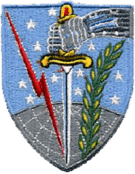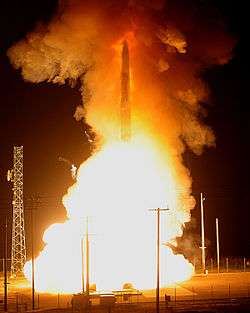12th Missile Squadron
| 12th Missile Squadron | |
|---|---|
|
LGM-30G Minuteman III test launch at Vandenberg AFB, California | |
| Active | 1940-1944; 1947-1949; 1955-1961; 1961-present |
| Country |
|
| Branch |
|
| Type | Squadron |
| Role | Intercontinental ballistic missile |
| Part of |
341st Operations Group Air Force Global Strike Command |
| Garrison/HQ | Malmstrom Air Force Base, Montana |
| Engagements |
World War II (American Campaign) |
| Decorations |
Air Force Outstanding Unit Award (7×) |
| Insignia | |
| 12th Strategic Missile Squadron emblem |
 |
| 12th Bombardment Squadron emblem (Approved 5 August 1957)[1] |
 |
The 12th Missile Squadron (12 MS) is a United States Air Force unit. It is assigned to the 341st Operations Group, stationed at Malmstrom Air Force Base, Montana. The 12 MS is equipped with the LGM-30G Minuteman III Intercontinental ballistic missile (ICBM), with a mission of nuclear deterrence.
Mission
The mission of the 341st Missile Wing is to keep America free and strong by providing combat-ready people and aerospace forces.[2]
History
World War II
The 12th Bombardment Squadron (Heavy) was organized and activated at Langley Field, Virginia, on 1 February 1940, as a member of the Twenty Fifth Bombardment Group (Heavy).[3] The unit moved from Langley where it trained initially, to Borinquen Field, Puerto Rico, being assigned to the 25th Bombardment Group, Caribbean Air Force on 1 November 1940. Following the initial deployment to Puerto Rico. The Squadron participated in various training and familiarization flights with its small complement of B-18 Bolo medium bombers, until 8 November 1941 when it was ordered to deploy to Benedict Field, St. Croix, temporarily until September 1942, then at St. Nicholas, and Antigua.[3][4]
Following the Pearl Harbor Attack, the Squadron commenced operations out of Benedict with its tiny force of three B-18's. However, these were exchanged for four slightly more efficacious B-18A's by 16 January 1942. By mid-February, these had been augmented by a further B-18 (while one of the B-18A's was away at Mobile Air Depot being fitted with one of the earliest airborne radar systems) and the Squadron had a total of four crews, three of whom had more than 12 months experience. Operations continued out of Benedict Field until 10 October 1942, when it moved to Dakota Field, Aruba and the following month came under the operational control of the Antilles Air Task Force and VI Fighter Command. By 11 December, the unit had six B-18B's and four Douglas A-20A Havocs while Flight "D" of the Squadron was at distant Borinquen Field with two further B-l8B's and a B-18. Apparently this aircraft dispersal proved too much for the unit to handle and, by January 1943, strength on report had dropped to a more reasonable total of just five B¬18B's and a single B-18C at Dakota Field, although Flight "D" remained at Borinquen as late as June, and Flight "C" moved from Dakota to Rio Hato Field, Panama from 1 June till 20 July 1943. In addition, several 59th Bombardment Squadron aircraft were attached to the 12th BS at this point, as were two Bell P-39D Airacobras of the 22d Pursuit Squadron.
All of this shuffling of aircraft was due, of course, to the exigencies of the anti-submarine campaign, which had been re-initiated in early January 1943. By October 1943, operational control of the now very experienced unit had passed to CAFAC (Commander, All Forces, Aruba and Curaçao), and the United States Navy assumed command and the unit, together with the Lockheed PV-1 Venturas of a Navy unit there provided continuous coverage for, amongst others, convoy GAT94 and its route from the time it entered the area.
As the anti-submarine war continuously shifted, the Squadron moved to follow, leaving Dakota Field on 23 November to move to Coolidge Field on Antigua, at which time its attachment to CAFAC ended. While there, it provided continuous coverage for Convoy TAG95. By the end of December, the unit had started to reequip, and had two of the B-18Bs, but also three North American B-25D Mitchells and not fewer than 12 B-25G's at Coolidge.
As the submarine war eased, the unit became, essentially, a crew training outfit, although patrols were still flown in conjunction with this tasking. The Squadron ended its Caribbean tour on 24 March 1944 when it was transferred back to the United States and became a B-25 Mitchell Operational Training Unit at Alamagardo Army Airfield, New Mexico. On 20 June 1944, the 12th Bombardment Squadron was disbanded.
Strategic Air Command
Eleven years later, on 1 September 1955, the 12th Bombardment Squadron, Medium, was activated at Abilene Air Force Base, Texas. Before being disbanded once more in 1961, the 12th’s B-47s engaged in training that made it a powerful element of the nation’s strategic air power.
Intercontinental Ballistic Missile Squadron
Reactivated on 1 December 1961 as an ICBM squadron assigned to the 341st Missile Wing at Malmstrom AFB, Montana. Initially equipped with 50 LGM-30A Minuteman Is in early 1962. Upon organization, it became the second Minuteman ICBM squadron in the Air Force. During the mid-1960s the 12th replaced its 50 Minuteman I missiles with Minuteman IIs. The 12th SMS was the first squadron at Malmstrom to undergo weapon system upgrade to Minuteman Mod; and on 22 April 1967, it was the first squadron to become fully operational with the new Minuteman II missiles under this program. The 12th SMS was also the first squadron in the wing to undergo silo upgrade. By 1978, the Improved Launch Control System (ILCS) had replaced the Minuteman Mod system and the 12th SMS once again had the state-of-the-art weapon system.
In 1994, the 12 MS reorganized under the objective squadron concept. This reorganization took the three combat disciplines, ICBM Operations, Security Police, and Electro- mechanical Maintenance, and combined them under the "one hat" of the missile squadron commander. In early June 1995, Electro-mechanical Maintenance returned to the Logistics Group. In February 1996, Missile Field Chefs became part of the 12 MS team.
The 12th Missile Squadron (MS) led the way in removing Minuteman II missiles and replacing them with LGM-30G Minuteman III silos from inactivating 321st Strategic Missile Wing at Grand Forks AFB, North Dakota in 1996; Minuteman IIs being retired. The new missile enhances capability, increases flexibility, and marks yet another system upgrade.[5]
Heraldry
On a disc of Light Blue sky spattered with White stars, the top of the globe issuing from base, Black, grid lines White; over all a Dark Gray mailed hand issuing from sinister chief, outlines and highlights White, details Light Blue, grasping a sword in pale, point to base, hilt and pommel AF Golden Yellow, blade White, shaded Light Blue, outlines and details Dark Gray, a Red oval spot on pommel, all between a Red lightning flash edged White and a Green Olive branch, details AF Golden Yellow, pilewise. Approved on 5 August 1957 (K 2568).
Lineage
- Constituted as the 12th Bombardment Squadron (Heavy) on 22 December 1939
- Activated on 1 February 1940
- Redesignated 12th Bombardment Squadron (Medium) on 7 May 1942
- Redesignated 12th Bombardment Squadron, Medium on 21 September 1943
- Disbanded on 20 June 1944
- Reconstituted and redesignated 12th Bombardment Squadron, Light on 10 March 1947
- Activated in the reserve on 24 July 1947
- Inactivated on 27 June 1949
- Redesignated 12th Bombardment Squadron, Medium on 7 June 1955
- Activated on 1 September 1955
- Discontinued and inactivated on 25 June 1961
- Redesignated 12th Strategic Missile Squadron (ICBM-Minuteman) and activated on 22 September 1961 (not organized)
- Organized on 1 March 1962
- Redesignated 12th Missile Squadron on 1 September 1991
Assignments
- 25th Bombardment Group, 1 February 1940 – 20 June 1944[6]
- Under operational control of Antilles Air Task Force and VI Bomber Command, 1 November 1942 – 20 June 1944[7]
- 341st Bombardment Group, 24 July 1947 – 27 June 1949
- 341st Bombardment Wing, 1 September 1955 – 25 June 1961
- Strategic Air Command, 22 September 1961 (not organized)
- 341st Strategic Missile Wing, 1 March 1962
- 341st Operations Group, 1 September 1991 – present
Stations
- Langley Field, Virginia, 1 February – 26 October 1940
- Borinquen Field, Puerto Rico, 1 November 1940
- Benedict Field, St Croix, c. 8 November 1941
- Dakota Field, Aruba, c. 10 October 1942
- Detachment operated from Borinquen Field, Puerto Rico, c. November 1942 – 23 November 1943
- Coolidge Field, Antigua, 23 November 1943 – 24 March 1944
- Alamogordo Army Air Field, New Mexico, 6 April – 20 June 1944
- Westover Field, Massachusetts, 24 July 1947
- Bradley Field, Connecticut, 24 October 1947 – 27 June 1949
- Abilene Air Force Base (later Dyess Air Force Base), Texas, 1 September 1955 – 25 June 1961
- Deployed at Andersen Air Force Base, Guam, 9 January – c. 4 April 1958
- Malmstrom Air Force Base, Montana, 1 March 1962 – present
Aircraft and Missiles
- B-18 Bolo, 1940–1944
- B-25 Mitchell, 1943–1944
- AT-6 Texan, 1947–1949
- AT-11 Kansan, 1947–1949
- B-47 Stratojet, 1956–1961
- LGM-30A/B Minuteman I, 1962–1968
- LGM-30F Minuteman II, 1968–1991
- LGM-30G Minuteman III, 1996 – present

12th Missile Squadron Launch Facilities
- Missile Alert Facilities (F-J flights, each controlling 10 missiles) are located as follows:[8]
- F-01 8.6 mi NxNE of Augusta MT, 47°36′17″N 112°18′38″W / 47.60472°N 112.31056°W
- G-01 13.8 mi SW of Simms MT, 47°19′32″N 112°05′39″W / 47.32556°N 112.09417°W
- H-01 5.9 mi NxNE of Fairfield MT,47°41′48″N 111°56′33″W / 47.69667°N 111.94250°W
- I-01 11.0 mi ExNE of Cascade MT, 47°18′45″N 111°28′25″W / 47.31250°N 111.47361°W
- J-01 7.0 mi ExNE of Power MT, 47°45′06″N 111°32′46″W / 47.75167°N 111.54611°W
See also
References
- ↑ Maurer, Combat Squadrons, pp. 64-65
- ↑ Factsheets : 341st MISSILE WING
- 1 2 Conaway, William. "12th Bombardment Squadron (Medium)". VI Bomber Command in Defense of the Panama Canal 1941 - 45.
- ↑ Maurer, Maurer (1983). Air Force Combat Units Of World War II. Maxwell AFB, AL: Office of Air Force History. ISBN 0-89201-092-4.
- ↑ 12th Missile Squadron [12th MS]
- ↑ Conaway, William. "25th Bombardment Group (Medium)". VI Bomber Command in Defense of the Panama Canal 1941 - 45.
- ↑ Conaway, William. "VI Bombardment Command History". Planes and Pilots Of World War Two.
- ↑ Malmstrom AFB Minuteman Missile Site Coordinates
![]() This article incorporates public domain material from the Air Force Historical Research Agency website http://www.afhra.af.mil/.
This article incorporates public domain material from the Air Force Historical Research Agency website http://www.afhra.af.mil/.
External links
- Conaway, William. "VI Bomber Command In Defense Of The Panama Canal 1941 - 45". Planes and Pilots Of World War Two.





.jpg)